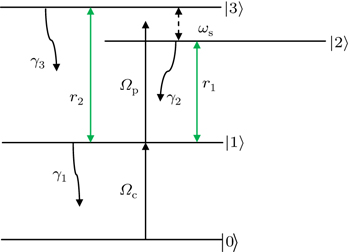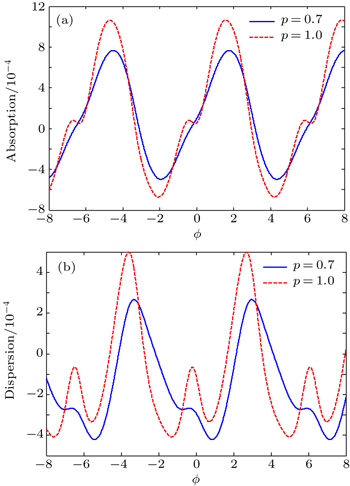† Corresponding author. E-mail:
Role of Fano interference and incoherent pumping field on optical bistability in a four-level designed InGaN/GaN quantum dot nanostructure embedded in a unidirectional ring cavity are analyzed. It is found that intensity threshold of optical bistability can be manipulated by Fano interference. It is shown that incoherent pumping fields make the threshold of optical bistability behave differently by Fano interference. Moreover, in the presence of Fano interference the medium becomes phase-dependent. Therefore, the relative phase of applied fields can affect the behaviors of optical bistability and intensity threshold can be controlled easily.
Recently, electromagnetically induced transparency (EIT), due to its potential applications in quantum information science and technology, has been studied by many research groups.[1–3] In this case, some related phenomena such as lasing without inversion (LWI),[4] four-wave mixing (FWM),[5–7] superluminal and subluminal light propagation,[8,9] enhanced Kerr nonlinearity,[10–12] and other[13–20] have been discussed theoretical or experimentally. Among these, optical bistability (OB) in multi-level atomic system embedded in a unidirectional ring cavity because of its wide applications in all-optical switches and logic circuits[21–25] has been the subject of many recent investigations. The researchers found that the intensity threshold of OB can be adjusted via different controllable parameters such as laser fields, phase fluctuation, quantum interference, and so on.
On the other hand, quantum coherence and interference based phenomena in semiconductor quantum wells (SQWs) or quantum dots (SQDs) have also been studied in past decade,[26–30] because of important applications in optoelectronic and solid-state quantum information science. For example, Yuan showed the slow light controlling of propagated light in vertically coupled InGaAs/GaAs quantum dots via electric fields.[26] In another study,[28] Yang et al. theoretically investigated the simultaneous formation and stable propagation of slow optical solitons pairs in SQDs with four-level biexciton-exciton cascade configuration. Moreover, the controlling of OB curves in SQWs and SQDs are also discussed by many research groups.[31–36] In fact, there are two different approaches for analyzing the optical bistability in SQWs. In the first approach,[31–36] multi-level quantum well systems can be used in a unidirectional ring cavity, and the OB can be induced via feedback mechanism of the cavity. However, in the second approach, the intrinsic OB can be obtained from the nonlinearities arising from the electron-electron interactions.[37–39]
In this paper, we use the first approach and study the optical bistability in a four-level InGaN/GaN quantum dot nanostructure confined a unidirectional ring cavity. It is demonstrated that the Fano interference for different rates of incoherent pumping rates can affect differently the properties of OB curves. Moreover, it is shown that the medium in the presence of Fano interference becomes phase-dependent, therefore the intensity threshold of OB can be easily controlled by relative phase of applied fields.
A four-level InGaN/GaN quantum dot nanostructure based on Ref. [40] is considered for studying the behaviors of optical bistability in a unidirectional ring cavity. The proportion values for calculating the wave functions and eigen-energies are as follows: the radius of quantum dot is 35 Å, the quantum dot barrier is 30 Å, the applied external voltage is 0.5 V, the length of quantum dot is 65 Å, and the number of obtained energy levels is 4. It is noted that these values result from solving the Schrödinger–Poisson equations self consistently for carrier in InGaN/GaN quantum dot’s conduction band. The normalized wave functions with related eigen-energies are shown in Fig. 

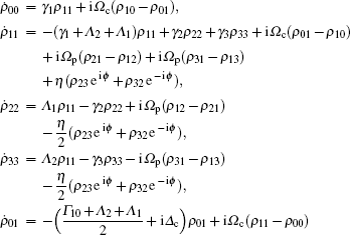




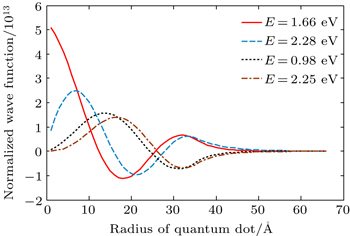 | Fig. 1. Wave functions of four-level InGaN/GaN quantum dot. Radius of quantum dot is 35 Å, and the thickness of shell (barrier) is 30 Å. |
Now, we consider a medium with length L composed of the above described QW structure in unidirectional ring cavity.[31–37] The dynamic response of the probe field under slowly varying envelop approximation is governed by Maxwell’s equations,










In this section, a few numerical results for the steady state of the output field intensity versus the input field intensity in order to control the threshold of OB are discussed. In the following, it is assumed that the electron–electron effects have very small influence on our results, and also parameters to be dimensionless units by scaling γ = 1 meV and Δp = 0.
First of all, the effect of the strength or quality of the interference on OB in the absence of incoherent pumping fields can be seen in Fig.
 | Fig. 3. Output field versus input field for different interference strengths p. The selected parameters are Ωc = 3γ, Δc = 0.0, Λ1 = Λ2 = 0, ϕ = 0, and C = 100. |
 | Fig. 4. Output field versus input field for different values of relative phase ϕ for (a) p = 0.7 and (b) p = 1. The selected parameters are the same as Fig. |
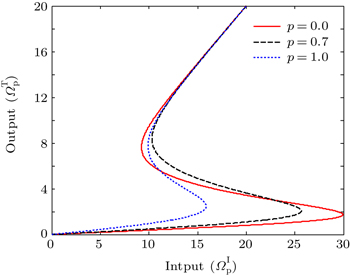 | Fig. 5. Output field versus input field for different interference strengths p. The selected parameters are Λ1 = 2γ and the others are the same as Fig. |
 | Fig. 6. Output field versus input field for different interference strengths p. The selected parameters are Λ1 = Λ2 = 2γ and the others are the same as Fig. |
 | Fig. 7. Absorption spectrum versus strength of Fano interference. The selected parameters are the same as Fig. |
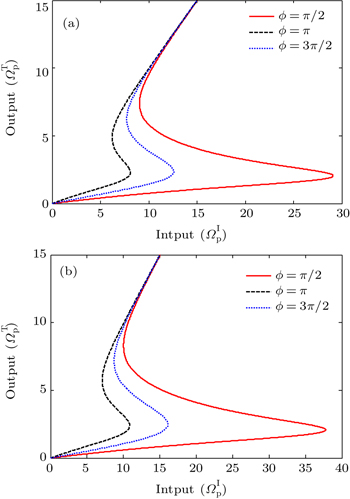 | Fig. 8. Output field versus input field for different values of relative phase ϕ for (a) p = 0.7 and (b) p = 1. The selected parameters are same as Fig. |
In summary, the OB behaviors of laser probe field which circulate in a unidirectional ring cavity composed of a four-level quantum dot nanostructure have been theoretically investigated. The effect of Fano interference in the absence and presence of incoherent pumping fields have been discussed and analyzed. It has been found that the OB threshold and hysteresis curve can be manipulated by strength of Fano interference and incoherent pumping rates. Moreover, it is found that in the presence of Fano interference the medium becomes phase-dependent. Therefore, by adjusting the relative phase of applied fields the behaviors of OB can be easily controlled.



